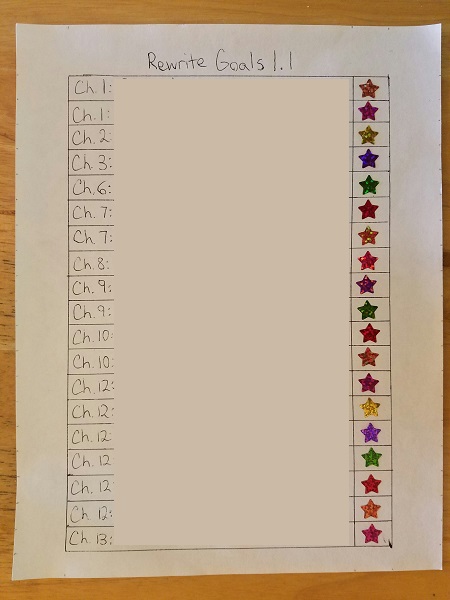When I found myself facing the task of actually sitting down and turning the loose outline and first three chapters I’d been poking at for two years into an actual book instead of just talking about it, I was terrified that it would turn out exactly like the previous books I’d tried to write. By which I mean: a miserable little pile of useless pages. This had happened at least three times and I was determined to actually finish something (besides a Legend of Zelda game) for once.
So after turning my half-baked outline into a chapter-by-chapter roadmap of where I wanted things to go, I grabbed a piece of paper and made a chart so I could keep track of my progress on the first draft. When I say “progress chart” you might be imagining an orderly little spreadsheet or a list with check marks on it. But my book takes place on Halloween, so I wanted my progress chart to look like a pumpkin patch instead:
 The top text says “FIRST DRAFT PROGRESS (because apparently I’m a six-year-old)”
The top text says “FIRST DRAFT PROGRESS (because apparently I’m a six-year-old)”
“How the hell is that a progress chart?” you might ask. Well, my book had fifteen chapters back then (I’ve since combined a few), so I scattered the numbers from 1 to 15 all over the page and every time I finished a chapter, I’d put a happy little jack-o-lantern sticker over that number.
Childish? Maybe. Did it work? Absolutely. Even though I knew the writing itself should have been satisfying, there was something about putting down a shiny sticker every time I finished a chapter that really filled me with determination.
Likewise, when it came time to assess the first draft’s flaws and try to correct them, I decided to make another chart. This time it would be much neater, and instead of pumpkins I used sparkly little star stickers:
 Edited because major, major spoilers.
Edited because major, major spoilers.
In addition to giving me a concrete visual way to keep track of my revision work, which is rather difficult otherwise, it gave me a way to quickly convey my progress to others – “Another happy little star sticker just went on the chart!” Again, maybe childish but I’m telling you, shiny or sparkly or colorful stickers have a power unlike anything else.
Recently I took stock of what I need to edit for Draft 1.2, and I put a new progress chart together. This time I’m gonna use little happy face stickers instead, mainly because I got a lot of things to fix and I’m running low on sparkly stars. I won’t bother posting a picture since there are no stickers on it yet, but trust me, it’s gonna look cute when it’s done.
Does this have a point?
Well, what I’m trying to say is: big things like revisions can seem really, really daunting. As I mentioned earlier, before this book the only large things I’d ever finished were Legend of Zelda games. But when you play a Zelda game, they don’t throw everything at you in one large chunk and expect you to just do it. They break it down into smaller tasks – explore this area, get this item, beat this dungeon. And at the end of each dungeon they give you some shiny thing so you feel like you’ve accomplished something. You don’t think “I’m still so far from defeating Ganon”; you think “Wow! I got the Forest Medallion!” It’s silly, but it works.
Using progress charts or breaking big tasks into smaller tasks isn’t new advice. But I’d like to add: don’t just make a progress chart, make a fun progress chart. Set it up however neatly or messily you want. Get some stickers or stamps or markers you like and use them to mark your progress. Make a pumpkin patch, make a constellation, make a neat little column of happy faces, make whatever you like. If anybody else judges you for it, the hell with them. Do whatever works for you. All that matters is that you get things done.
Well, that’s our show, thanks for watching. If you’ll excuse me, I have to go put a happy face sticker on my new progress chart.